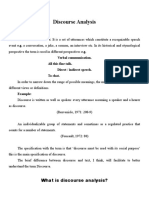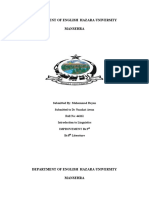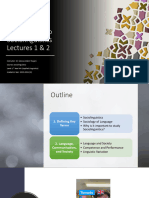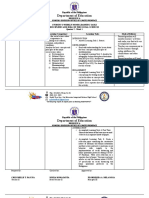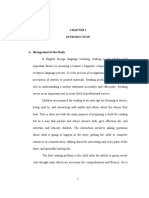0 ratings0% found this document useful (0 votes)
35 viewsTopic 1 Defining Discourse
Discourse analysis is the study of language use above the sentence level and in its proper context. It examines how language is used in specific discourses or contexts rather than as an isolated system. Discourse analysis focuses on describing language use through approaches like register analysis, thematic development, pragmatics, and conversation analysis. It was introduced by Zellig Harris in 1952 to analyze speech and writing beyond the sentence level and examine the relationship between language and behavior in context.
Uploaded by
Noor Asheeqa Zahwa AzizCopyright
© © All Rights Reserved
Available Formats
Download as PDF, TXT or read online on Scribd
0 ratings0% found this document useful (0 votes)
35 viewsTopic 1 Defining Discourse
Discourse analysis is the study of language use above the sentence level and in its proper context. It examines how language is used in specific discourses or contexts rather than as an isolated system. Discourse analysis focuses on describing language use through approaches like register analysis, thematic development, pragmatics, and conversation analysis. It was introduced by Zellig Harris in 1952 to analyze speech and writing beyond the sentence level and examine the relationship between language and behavior in context.
Uploaded by
Noor Asheeqa Zahwa AzizCopyright
© © All Rights Reserved
Available Formats
Download as PDF, TXT or read online on Scribd
You are on page 1/ 20
Topic 1:
Defining Discourse Analysis
Discourse Analysis for ELT @ Azannee 1
Discourse Discourse
Discourse?
studies? analysis?
Discourse Analysis for ELT @ Azannee 2
Discourse:
• “language in its context of use” (Flowerdew, 2013)
• When looking at language in use, it is language above the
sentence level => ‘extended text’
• This draws major distinction between Discourse and
generative linguistics (Chomsky) => contextualised vs.
decontextualised
Discourse Analysis for ELT @ Azannee 3
Contextualized Decontextualized
• Language is seen/analysed • Language is analysed as
on how it is used in specific separate entity from context
context
• Focus is on language
• It is concerned with more structure
than (just) grammar and
vocabulary. E.g. how people
participate in conversation
Discourse Analysis for ELT @ Azannee 4
A more restricted definition:
• The term “discourse” is used to refer to specific set of ideas
and how these ideas are articulated
• For example: the discourse of feminism (language used by
feminist), the discourse of parent-child (language used in
conversation between parents and their children) or political
discourse (language used by politicians)
Discourse Analysis for ELT @ Azannee 5
So, what is Discourse Analysis?
• Discourse Analysis (or recent term being used ‘Discourse
Studies’) is THE STUDY on how language is used in specific
discourse
• The term Discourse Studies is deemed to be more suitable
for methodological reason => analysis gives indication that
the area is only concerned with analysis; but actual
Discourse Analysis is also concerned with theory and
application
Discourse Analysis for ELT @ Azannee 6
But, to avoid confusion…
We can (loosely) say:
• Discourse Analysis refers to the actual
analysis (methodologically speaking)
• Discourse Studies refers to the discipline
Discourse Analysis for ELT @ Azannee 7
A bit of history
Discourse Analysis was introduced by Zellig Harris in 1952
It is introduced as a method to analyse speech and writing
Two interests of Harris through Discourse Analysis:
a. Examining language beyond sentence level
b. Looking at relationship between linguistic and non-
linguistic behaviour
Discourse Analysis for ELT @ Azannee 8
Zellig Harris
• Zellig Sabbetai Harris (1909-1992)
• American linguist, mathematician
and methodological scientist
• His original focus was on Semitic
languages, language group
originating from the North Africa
and Middle East
• His works include Mathematical
Structure of Language (1968)
Discourse Analysis for ELT @ Azannee 9
According to him;
“connected discourse occurs within a particular situation –
whether of a person speaking, or of a conversation, or of
someone sitting down occasionally over the period of months
to write a particular kind of book in a particular literary or
scientific tradition”
• There are typical ways of using language in particular
situations
• There are specific linguistic features associated to specific
discourse
Discourse Analysis for ELT @ Azannee 10
Discourse Structure and Discourse Function
• Or “form vs. function” (McCarthy, 1991)
• When doing Discourse Analysis, you may perform structural
analysis or functional analysis
• Discourse structure: the text (spoken/written) would be
broken down into component parts. The parts can be topics
or turns (spoken) or paragraphs or sentences (written)
• Discourse function: discourse analysts will consider particular
meanings associated what is said/written. Basically, it tries to
answer “how language is used?”
Discourse Analysis for ELT @ Azannee 11
• Examples of questions that function approach will be helpful
to answer:
a. How teachers use language in classroom?
b. What is the linguistic identity of specific group of people?
c. How politicians make persuasive speech?
• These kinds of question suggest Discourse Analysis to be a
qualitative approach rather than quantitative => the concern
is not to measure but to describe
Discourse Analysis for ELT @ Azannee 12
Example:
6 L tak (.) kakak pernah tengok dalam t- dalam cerite:
no TOA has watched on Ø on movie
no I have watched on t- on movie
((L looked at other direction))
7 M cerite ape?
movie what
what movie
8 L cerite:: pade zaman dahulu
movie once upon a time
movie (on) once upon a time
9 M pade zaman dahulu (.) yang macam upin ipin tu
once upon a time which similar TOA that
once upon a time,(one) similar to that upin ipin
Discourse Analysis for ELT @ Azannee 13
You will see Discourse Analysis in:
• Linguistics (closely related)
• Communication studies
• Educational studies
• Law
• Psychology
• Health communication
Discourse Analysis for ELT @ Azannee 14
Data for Discourse Analysis
• The key word is “TEXT”
• In Discourse Analysis, text is linguistic units in the form of
sentences/speech that are lengthened (more than one
sentence)
• It can be any sort of text in spoken or written form
Discourse Analysis for ELT @ Azannee 15
Examples of written text:
a. Textbooks
b. News reports
c. Letters
d. Emails
Examples of spoken text:
a. Casual conversation
b. Classroom lessons
c. Faculty meetings
d. Doctor’s consultation
Discourse Analysis for ELT @ Azannee 16
Approaches to Discourse Studies
In doing the analysis, various approaches can be adopted:
a. Register analysis
b. Thematic development
c. Pragmatics
d. Conversation Analysis
e. Genre Analysis
f. Corpus-based Discourse Analysis
Discourse Analysis for ELT @ Azannee 17
Discourse Studies focus on language in its
contexts of use
What is CONTEXT? (Hymes, 1972):
a. The physical or temporal setting
b. The participants (speaker/writer)
c. The purposes of participants
d. The communicative channel
e. The attitude of participants
f. The genre
g. Background knowledge
Discourse Analysis for ELT @ Azannee 18
• van Dijk (2008) stated contexts are subjective constructs that
develop over the course of an interaction; participants define
their contexts according to their subjective interpretations
=> hence, it is a sociocognitive phenomenon, not just social
• Bloomaert (2001) said, it is crucial to carefully select what is
relevant in the context when interpreting text
Discourse Analysis for ELT @ Azannee 19
Discourse Analysis for ELT @ Azannee 20
You might also like
- GROUP 3_Critical Discourse Analysis in ELTNo ratings yetGROUP 3_Critical Discourse Analysis in ELT17 pages
- Discourse Analysis and Second Language Writing - Wennerstrom Chap 01No ratings yetDiscourse Analysis and Second Language Writing - Wennerstrom Chap 0116 pages
- Lecture 1stintroduction To Discourse Analysis023928pptx 255605057No ratings yetLecture 1stintroduction To Discourse Analysis023928pptx 25560505736 pages
- lecture1st-introductiontodiscourseanalysis-230130221712-8a5b6d3fNo ratings yetlecture1st-introductiontodiscourseanalysis-230130221712-8a5b6d3f36 pages
- Discourse Analysis: Dr. Muhammad Shahbaz M.shahbaz@gcwus - Edu.pk 0345-6725710No ratings yetDiscourse Analysis: Dr. Muhammad Shahbaz M.shahbaz@gcwus - Edu.pk 0345-672571034 pages
- Discourse Analysis: An Introductory LectureNo ratings yetDiscourse Analysis: An Introductory Lecture22 pages
- Mc Leod Introducing Discourse Analysis Qualitative Research 2024No ratings yetMc Leod Introducing Discourse Analysis Qualitative Research 202420 pages
- Discourse Analysis and Teaching BookletNo ratings yetDiscourse Analysis and Teaching Booklet27 pages
- Basic Concepts: What Is Discourse? What Is Discourse Analysis?No ratings yetBasic Concepts: What Is Discourse? What Is Discourse Analysis?22 pages
- What Is Discourse Analysis - An Introduction & Guide - DelveNo ratings yetWhat Is Discourse Analysis - An Introduction & Guide - Delve50 pages
- ANÁLISIS DEL DISCURSO EN LENGUA INGLESANo ratings yetANÁLISIS DEL DISCURSO EN LENGUA INGLESA64 pages
- Chapter IV. Principles of Discourse Analysis. Principles of Discourse Analysis. Principles of Discourse Analysis100% (1)Chapter IV. Principles of Discourse Analysis. Principles of Discourse Analysis. Principles of Discourse Analysis31 pages
- Discourse Analysis: Discourse Analysis Examines Patterns of Language Across Texts andNo ratings yetDiscourse Analysis: Discourse Analysis Examines Patterns of Language Across Texts and15 pages
- Discourse Analysis: Topics in Applied Linguistics Widhiaistuti@staff - Unnes.ac - IdNo ratings yetDiscourse Analysis: Topics in Applied Linguistics Widhiaistuti@staff - Unnes.ac - Id28 pages
- Engl 321/ Elcs 322 Discourse Analysis Laikipia University Department of Literary and Communication StudiesNo ratings yetEngl 321/ Elcs 322 Discourse Analysis Laikipia University Department of Literary and Communication Studies51 pages
- Week One Introduction to Discourse AnalysisNo ratings yetWeek One Introduction to Discourse Analysis9 pages
- Applied Linguistics: A Genre Analysis Of: Research Articles Results and Discussion Sections in Journals Published in Applied LinguisticsFrom EverandApplied Linguistics: A Genre Analysis Of: Research Articles Results and Discussion Sections in Journals Published in Applied LinguisticsNo ratings yet
- Saint Michael College of Caraga: Tel. Nos. Fax NoNo ratings yetSaint Michael College of Caraga: Tel. Nos. Fax No7 pages
- Humanising_Language_Teaching_Magazine_for_teachers_and_teacher_trainersNo ratings yetHumanising_Language_Teaching_Magazine_for_teachers_and_teacher_trainers1 page
- M1 - The Alphabet Soup of Teaching EnglishNo ratings yetM1 - The Alphabet Soup of Teaching English6 pages
- Introduction To Sociolinguistics Lectures 1 & 2No ratings yetIntroduction To Sociolinguistics Lectures 1 & 220 pages
- Department of Education: Republic of The PhilippinesNo ratings yetDepartment of Education: Republic of The Philippines2 pages
- Unpacking Kirkpatrick: Data-Driven Decision Making in L&DNo ratings yetUnpacking Kirkpatrick: Data-Driven Decision Making in L&D21 pages
- Ok PTS 1 - Questionnaire To Determine Learners StyleNo ratings yetOk PTS 1 - Questionnaire To Determine Learners Style3 pages
- Least Mastered Competencies SY 2020-2021No ratings yetLeast Mastered Competencies SY 2020-20219 pages
- Improving Students' Reading Skill Through Communicative Language Teaching Method Chapter INo ratings yetImproving Students' Reading Skill Through Communicative Language Teaching Method Chapter I13 pages
- Andrew Siebert: Industrial Product DesignerNo ratings yetAndrew Siebert: Industrial Product Designer1 page
- Nygren Presentation 2023 UCL Lecture PSYC0021No ratings yetNygren Presentation 2023 UCL Lecture PSYC002121 pages
- (Luận văn) a translation quality assessment of the first three chapters of the novel the da vinci code by do thu ha (2005) based on j houses modelNo ratings yet(Luận văn) a translation quality assessment of the first three chapters of the novel the da vinci code by do thu ha (2005) based on j houses model83 pages
- Unit 6 - Art and Philosophy - Hedonism & Functionalism (Pedrosa, Mia Nicole)No ratings yetUnit 6 - Art and Philosophy - Hedonism & Functionalism (Pedrosa, Mia Nicole)4 pages
- English Language Learners and Students With AutismNo ratings yetEnglish Language Learners and Students With Autism8 pages
- Roles Creative Thinking and Problem Solving EngNo ratings yetRoles Creative Thinking and Problem Solving Eng2 pages
- Discourse Analysis and Second Language Writing - Wennerstrom Chap 01Discourse Analysis and Second Language Writing - Wennerstrom Chap 01
- Lecture 1stintroduction To Discourse Analysis023928pptx 255605057Lecture 1stintroduction To Discourse Analysis023928pptx 255605057
- lecture1st-introductiontodiscourseanalysis-230130221712-8a5b6d3flecture1st-introductiontodiscourseanalysis-230130221712-8a5b6d3f
- Discourse Analysis: Dr. Muhammad Shahbaz M.shahbaz@gcwus - Edu.pk 0345-6725710Discourse Analysis: Dr. Muhammad Shahbaz M.shahbaz@gcwus - Edu.pk 0345-6725710
- Mc Leod Introducing Discourse Analysis Qualitative Research 2024Mc Leod Introducing Discourse Analysis Qualitative Research 2024
- Basic Concepts: What Is Discourse? What Is Discourse Analysis?Basic Concepts: What Is Discourse? What Is Discourse Analysis?
- What Is Discourse Analysis - An Introduction & Guide - DelveWhat Is Discourse Analysis - An Introduction & Guide - Delve
- Chapter IV. Principles of Discourse Analysis. Principles of Discourse Analysis. Principles of Discourse AnalysisChapter IV. Principles of Discourse Analysis. Principles of Discourse Analysis. Principles of Discourse Analysis
- Discourse Analysis: Discourse Analysis Examines Patterns of Language Across Texts andDiscourse Analysis: Discourse Analysis Examines Patterns of Language Across Texts and
- Discourse Analysis: Topics in Applied Linguistics Widhiaistuti@staff - Unnes.ac - IdDiscourse Analysis: Topics in Applied Linguistics Widhiaistuti@staff - Unnes.ac - Id
- Engl 321/ Elcs 322 Discourse Analysis Laikipia University Department of Literary and Communication StudiesEngl 321/ Elcs 322 Discourse Analysis Laikipia University Department of Literary and Communication Studies
- Applied Linguistics: A Genre Analysis Of: Research Articles Results and Discussion Sections in Journals Published in Applied LinguisticsFrom EverandApplied Linguistics: A Genre Analysis Of: Research Articles Results and Discussion Sections in Journals Published in Applied Linguistics
- Dimensions in Discourse: Elementary to EssentialsFrom EverandDimensions in Discourse: Elementary to Essentials
- Humanising_Language_Teaching_Magazine_for_teachers_and_teacher_trainersHumanising_Language_Teaching_Magazine_for_teachers_and_teacher_trainers
- Department of Education: Republic of The PhilippinesDepartment of Education: Republic of The Philippines
- Unpacking Kirkpatrick: Data-Driven Decision Making in L&DUnpacking Kirkpatrick: Data-Driven Decision Making in L&D
- Ok PTS 1 - Questionnaire To Determine Learners StyleOk PTS 1 - Questionnaire To Determine Learners Style
- Improving Students' Reading Skill Through Communicative Language Teaching Method Chapter IImproving Students' Reading Skill Through Communicative Language Teaching Method Chapter I
- (Luận văn) a translation quality assessment of the first three chapters of the novel the da vinci code by do thu ha (2005) based on j houses model(Luận văn) a translation quality assessment of the first three chapters of the novel the da vinci code by do thu ha (2005) based on j houses model
- Unit 6 - Art and Philosophy - Hedonism & Functionalism (Pedrosa, Mia Nicole)Unit 6 - Art and Philosophy - Hedonism & Functionalism (Pedrosa, Mia Nicole)
- English Language Learners and Students With AutismEnglish Language Learners and Students With Autism























